Hayden Winks’ Ideal 2021 Fantasy Football Draft
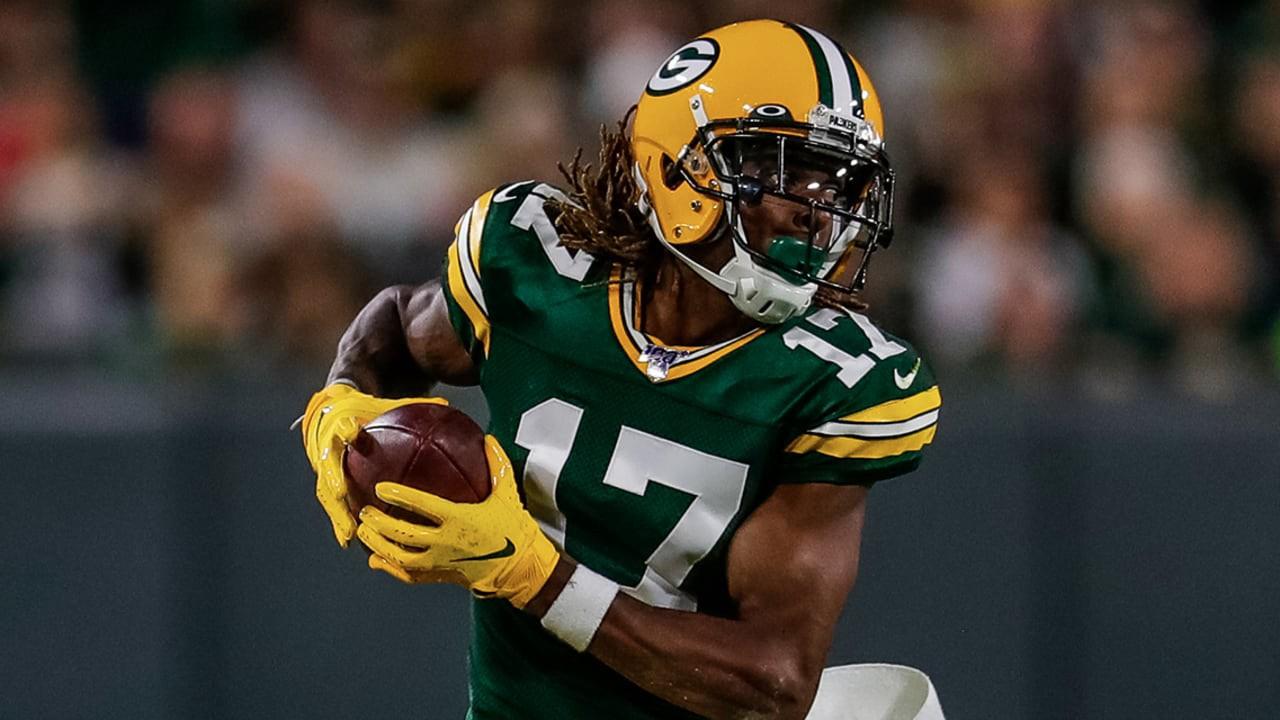
In The Underdog Football Show Draft Guide, we were tasked with coming up with our “Ideal Draft” for Underdog Fantasy best ball. We had to stay next to ADP for this exercise, so we didn’t get any screaming values here. Instead, we had to build a team that’s very achievable but still worthy of a high-ceiling finish in Best Ball Mania II or the Puppy II.
Speaking of that, here’s a $25 bonus with any first-time deposit using the link below or promo code ‘UNDERBLOG’. That will get you an entry into BBM2, our $3.5 million tournament with a grand prize of just over $1 million.
Hayden Winks' Ideal Fantasy Draft
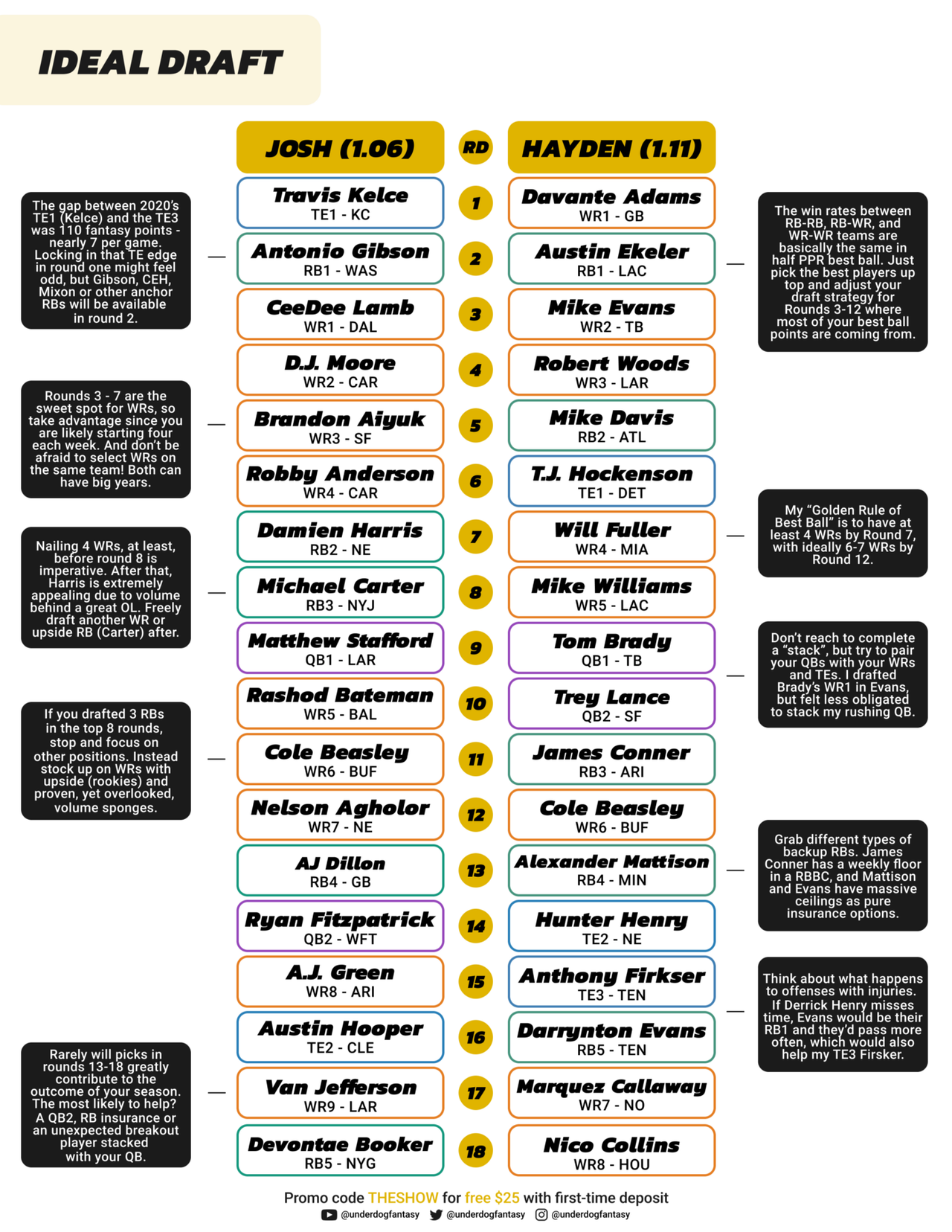
I opted for a very standard 2QB-5RB-8WR-3TE build, something that you’ll see falls into the optimal range for each position. Of course, roster construction shouldn’t be viewed through the lens of 18 rounds only because most of our best ball scoring production comes from our first 12 picks. I’ll break down why I ended up with this construction in a second.
When it came to stacking, I found 3 ways to get it — Tom Brady and Mike Evans, Austin Ekeler and Mike Williams, and Anthony Firkser and Darrynton Evans. We all know that stacking a QB with a WR is smart, but there’s still some slightly positive correlation between the other positions on the same roster, too. Austin Ekeler and Mike Williams can both have a spiked week in the best ball playoffs if the Chargers are trailing going into halftime, especially if Keenan Allen were to miss time. Anthony Firkser and Darrynton Evans are massively correlated at the highest outcomes, when Derrick Henry misses time. A Big Dog injury would vault Evans into a 15+ touch role and would make the Titans more pass heavy in general, particularly in the red zone where Firkser could be maximized. When I’m doing non-QB stacks, I like to do them when they don’t involve high-end draft picks. For example, I drafted Austin Ekeler over Aaron Jones at the 2.14 here because Davante Adams’ ceiling outcomes are unlocked when Jones is out or not being a focal point of the offense.
When To Draft QBs In Fantasy
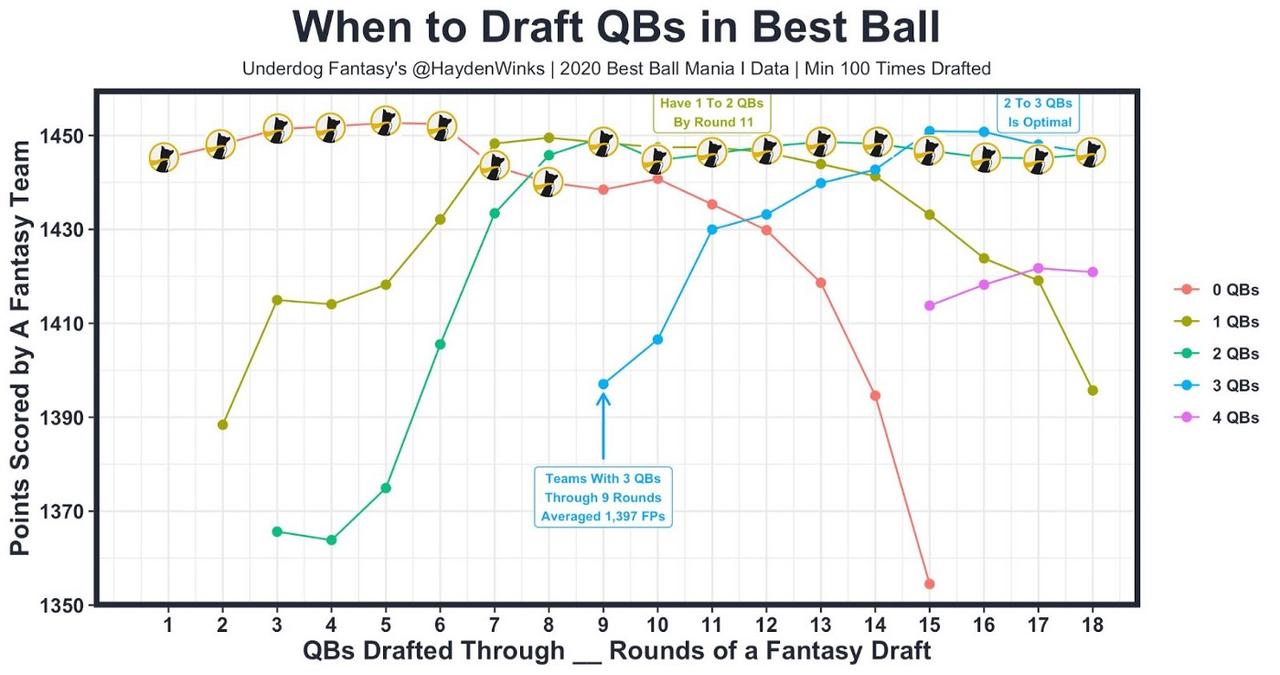
I drafted Tom Brady (Round 9) & Trey Lance (Round 10). Brady averaged 22.6 fantasy points per game after his Week 12 bye week including playoffs where he dominated on the road. That per game average would’ve made him the QB7 last year, so I’m interested in him around QB10, particularly after already committing to Mike Evans in Round 3. Trey Lance has massive upside if given starts, and I’m not banking on him early in the year with Brady providing plenty of ceiling/floor early in the year.
Based on last year’s Best Ball Mania data, my roster construction path was optimal at nearly every round. The chart above shows how many points teams averaged depending on how many QBs they had at each round of the draft. My roster construction path is highlighted by the very cute Underdog Fantasy logo. In general, we want 1–2 QBs by Round 11 and 2–3 QBs at the end of the draft.
When To Draft RBs in Fantasy Football
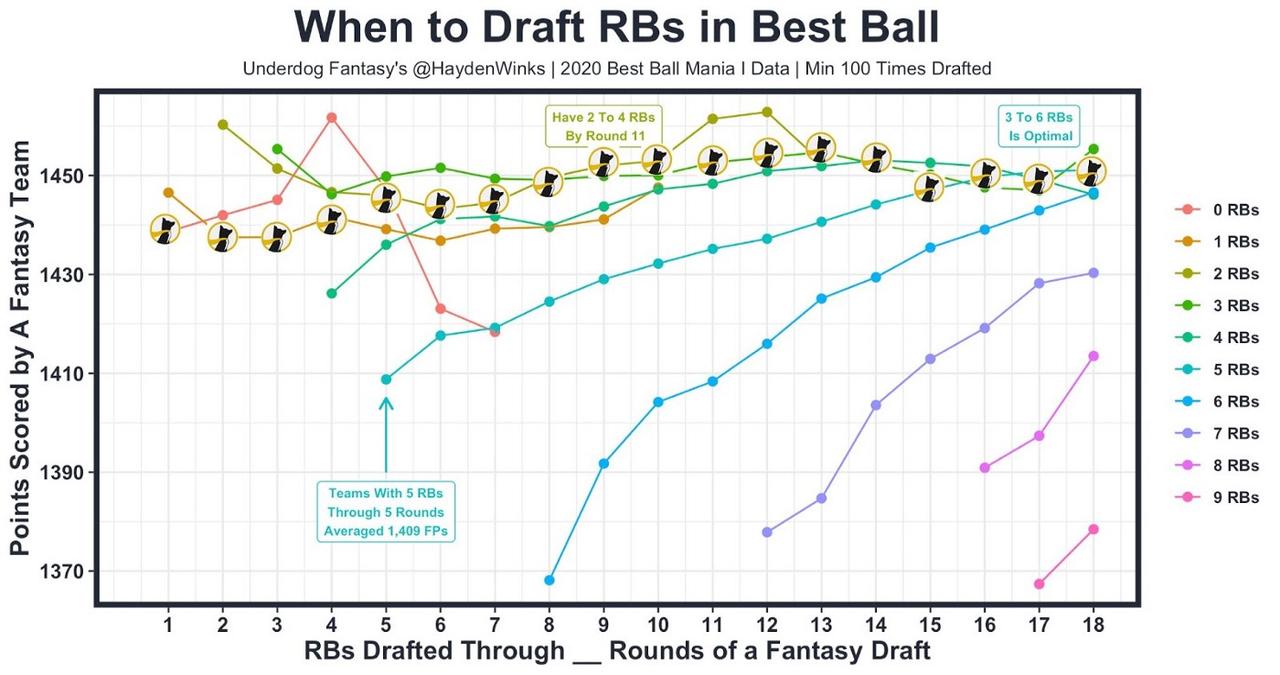
I drafted Austin Ekeler (Round 2), Mike Davis (Round 5), James Conner (Round 11), Alexander Mattison (Round 13), and Darrynton Evans (Round 16). I’m not sure what to call this draft strategy because it’s kinda between Hero RB and Bimodal RB. I’m essentially committed to Ekeler having an elite season and Davis holding off the haters (of which there are many) as a high-ceiling RB2 in a functional Atlanta offense with bad RB depth. Because I felt weaker than the field at RB, I opted for 5 RBs instead of 4, something I do often if I start RB-RB. My backup RBs complement each other, too. Conner has a chance to compete with Davis every week as my RB2/FLEX, while Mattison and Evans have massive ceilings in the event of injuries.
My roster construction path was pretty good, particularly in the back half of the draft. In general, I think most drafters are selecting their RB3, RB4, and RB5 too early. It was optimal to have only 2 or 3 RBs through Round 10 last year, and the RB5 didn’t become optimal until Round 15 or so. Of course, RBs are being drafted way later this year, so some slight adjustments are needed:
When To Draft WRs in Fantasy Football
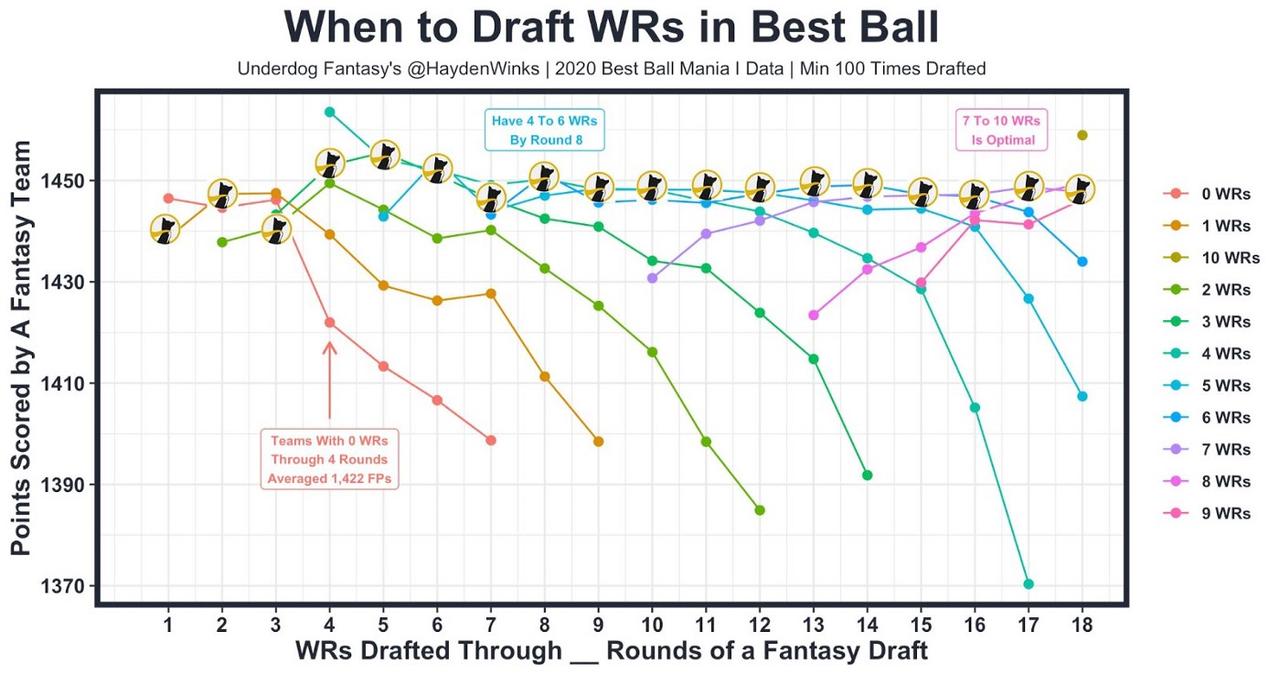
I drafted Davante Adams (Round 1), Mike Evans (Round 3), Robert Woods (Round 4), Will Fuller (Round 7), Mike Williams (Round 8), Cole Beasley (Round 12), Marquez Callaway (Round 17), and Nico Collins (Round 18). It was a WR-heavy build in general with 3-of-4 early picks going to proven №1 WRs attached to great QBs. With their ceiling/floor combos, I was willing to take risks in the middle rounds with Fuller and Williams, both of whom are better in best ball. By drafting Fuller in Round 7, I completed my “Golden Rule of Best Ball”, which is having 4 WRs by Round 7. After drafting Beasley at a suppressed ADP, I felt good about my top-6 WRs, so I waited until the last 2 rounds to round out my WR group with youngsters.
Based on last year’s data, my roster construction path was optimal throughout. With WR prices up by 1–2 rounds on average in the middle rounds, I made sure to get some studs early and avoid the WR inflation of Rounds 10–16. If you want to read more about WR best ball strategy, I wrote “When Do You Have Too Many WRs on Underdog Fantasy?”.
When To Draft TEs in Fantasy Football
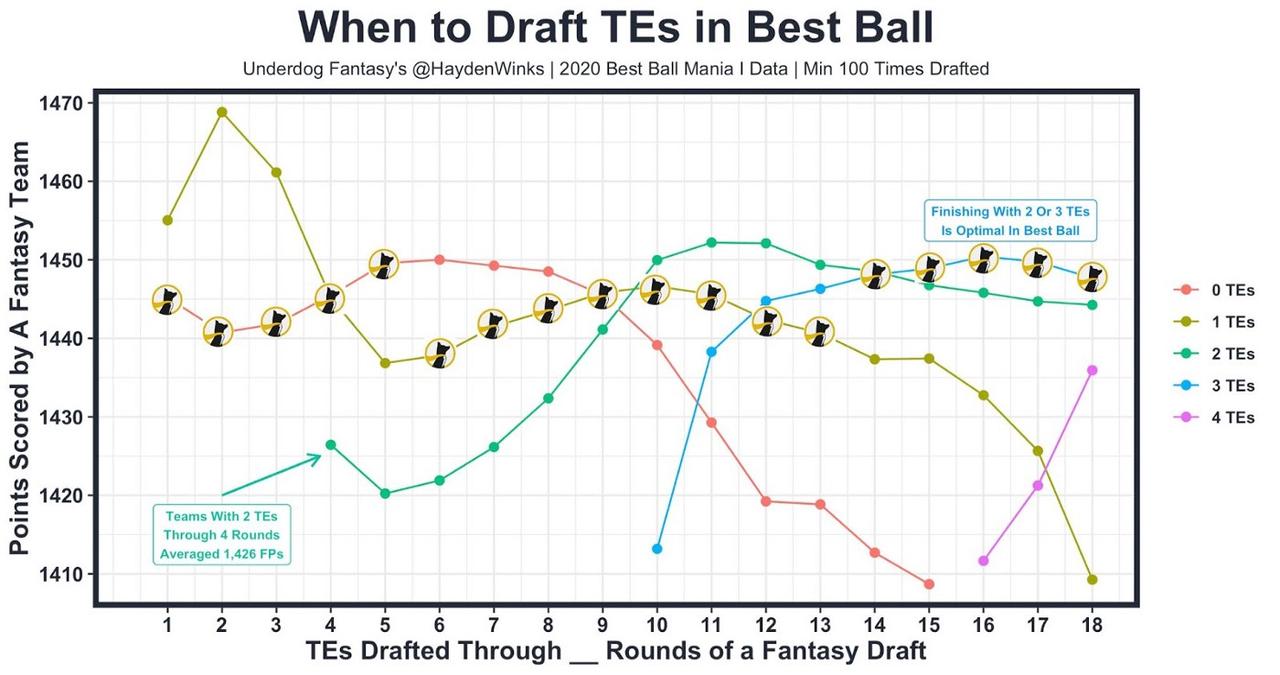
I drafted T.J. Hockenson (Round 6), Hunter Henry (Round 14), and Anthony Firkser (Round 15). Drafting mid-range TE1s has historically been a very tough scene, but I didn’t want to be weak at QB and TE in a 155k-entry tournament, so I rolled the dice on Hockenson. He was the TE6 per game on TE6 fantasy usage last year, and there’s somehow even less target competition in 2021. A little touchdown luck or a third-year breakout gives Hockenson paths to the Waller/Kittle tier. I like Henry’s odds of beating Jonnu Smith in snaps and routes this year, and I think he’s the Patriots’ best receiving option in the red zone, too. Firkser checks two primary boxes as a TE2 sleeper — slot snaps and being in an efficient offense. No qualifying TE had a higher percentage of snaps in the slot than Firk Daddy last year.
Please ignore the roller coaster ride of the early-round portion of this chart. A one-year sample of a onesie position is not worth chasing. With that said, I think last year’s data becomes more stable the further into the draft we go because that’s when more TEs were drafted. It was optimal to have 1–2 TEs at Round 11 and 2–3 TEs at the end of the draft. That’s the model I followed by anchoring Hockenson early and adding Henry/Firkser depth late. Hopefully these three TEs can ping pong their TD scoring on different weeks and that difference closes the gap on Kelce/Waller/Kittle teams.